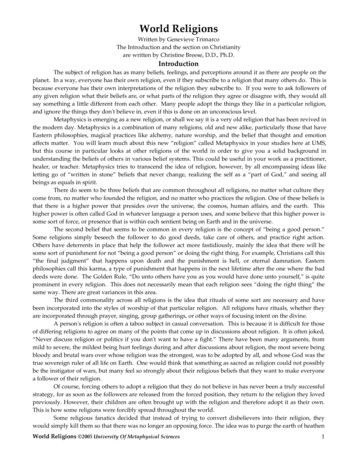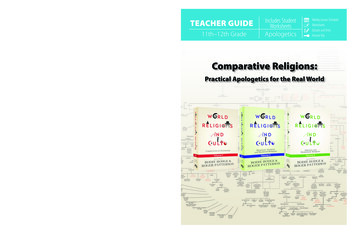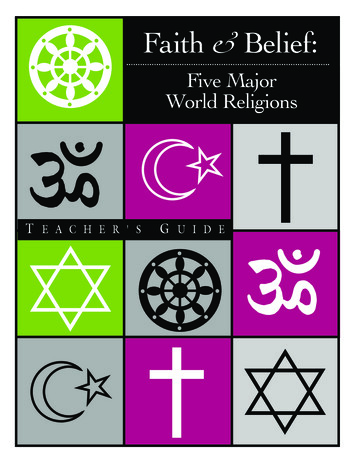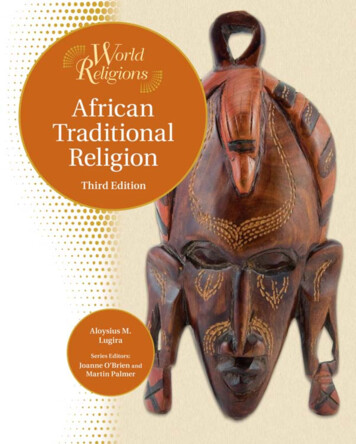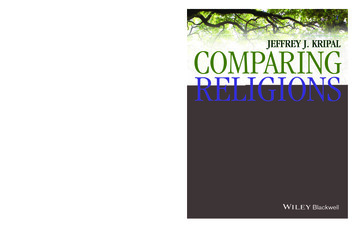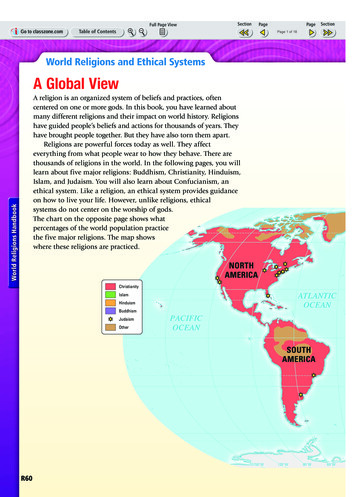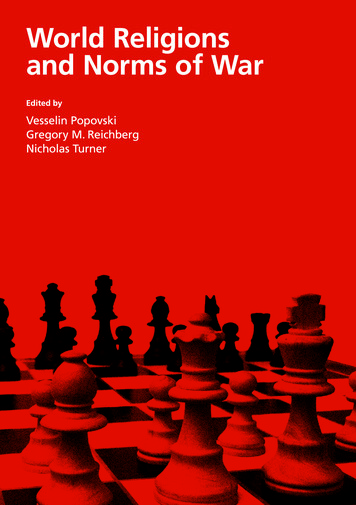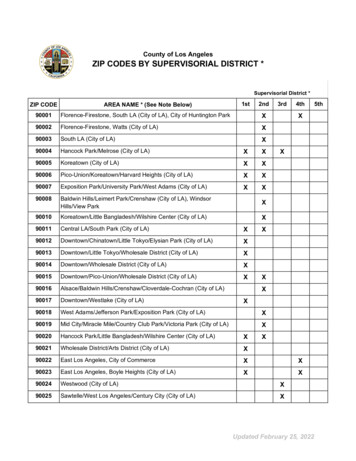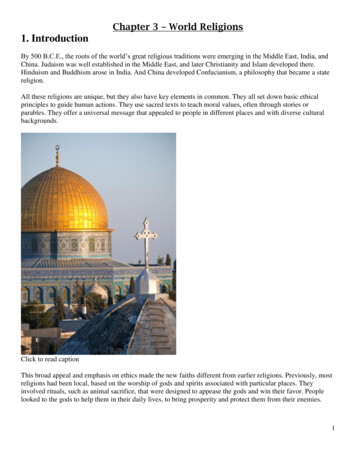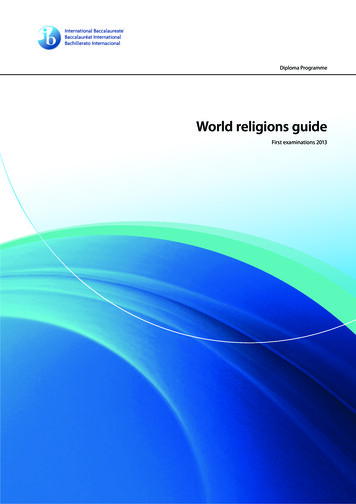
Transcription
Diploma ProgrammeWorld religions guideFirst examinations 2013
Diploma ProgrammeWorld religions guideFirst examinations 2013
Diploma ProgrammeWorld religions guidePublished May 2011International BaccalaureatePeterson House, Malthouse Avenue, Cardiff GateCardiff, Wales GB CF23 8GLUnited KingdomPhone: 44 29 2054 7777Fax: 44 29 2054 7778Website: http://www.ibo.org International Baccalaureate Organization 2011The International Baccalaureate (IB) offers three high quality and challengingeducational programmes for a worldwide community of schools, aiming to createa better, more peaceful world.The IB is grateful for permission to reproduce and/or translate any copyrightmaterial used in this publication. Acknowledgments are included, whereappropriate, and, if notified, the IB will be pleased to rectify any errors or omissionsat the earliest opportunity.All rights reserved. No part of this publication may be reproduced, stored in aretrieval system, or transmitted, in any form or by any means, without the priorwritten permission of the IB, or as expressly permitted by law or by the IB’s ownrules and policy. See http://www.ibo.org/copyright.IB merchandise and publications can be purchased through the IB store athttp://store.ibo.org. General ordering queries should be directed to the sales andmarketing department in Cardiff.Phone: 44 29 2054 7746Fax: 44 29 2054 7779Email: sales@ibo.orgInternational Baccalaureate, Baccalauréat International and Bachillerato Internacionalare registered trademarks of the International Baccalaureate Organization.Printed in the United Kingdom by Antony Rowe Ltd, Chippenham, Wiltshire3117
IB mission statementThe International Baccalaureate aims to develop inquiring, knowledgeable and caring young people who help tocreate a better and more peaceful world through intercultural understanding and respect.To this end the organization works with schools, governments and international organizations to developchallenging programmes of international education and rigorous assessment.These programmes encourage students across the world to become active, compassionate and lifelong learnerswho understand that other people, with their differences, can also be right.IB learner profileThe aim of all IB programmes is to develop internationally minded people who, recognizing their commonhumanity and shared guardianship of the planet, help to create a better and more peaceful world.IB learners strive to be:InquirersThey develop their natural curiosity. They acquire the skills necessary to conduct inquiryand research and show independence in learning. They actively enjoy learning and thislove of learning will be sustained throughout their lives.KnowledgeableThey explore concepts, ideas and issues that have local and global significance. In sodoing, they acquire in-depth knowledge and develop understanding across a broad andbalanced range of disciplines.ThinkersThey exercise initiative in applying thinking skills critically and creatively to recognizeand approach complex problems, and make reasoned, ethical decisions.CommunicatorsThey understand and express ideas and information confidently and creatively in morethan one language and in a variety of modes of communication. They work effectivelyand willingly in collaboration with others.PrincipledThey act with integrity and honesty, with a strong sense of fairness, justice and respectfor the dignity of the individual, groups and communities. They take responsibility fortheir own actions and the consequences that accompany them.Open-mindedThey understand and appreciate their own cultures and personal histories, and are opento the perspectives, values and traditions of other individuals and communities. They areaccustomed to seeking and evaluating a range of points of view, and are willing to growfrom the experience.CaringThey show empathy, compassion and respect towards the needs and feelings of others.They have a personal commitment to service, and act to make a positive difference to thelives of others and to the environment.Risk-takersThey approach unfamiliar situations and uncertainty with courage and forethought,and have the independence of spirit to explore new roles, ideas and strategies. They arebrave and articulate in defending their beliefs.BalancedThey understand the importance of intellectual, physical and emotional balance toachieve personal well-being for themselves and others.ReflectiveThey give thoughtful consideration to their own learning and experience. They are ableto assess and understand their strengths and limitations in order to support their learningand personal development. International Baccalaureate Organization 2007
ContentsIntroduction 1Purpose of this document 1The Diploma Programme 2Nature of the subject 4Aims 6Assessment objectives 7Assessment objectives in practice 8Syllabus 9Syllabus outline 9Approaches to the teaching of world religions 10Part 1: Introduction to world religions 12Part 2: In-depth studies 17Assessment 47Assessment in the Diploma Programme 47Assessment outline 49External assessment 50Internal assessment 55Appendix 64Glossary of command terms World religions guide64
IntroductionPurpose of this documentThis publication is intended to guide the planning, teaching and assessment of the subject in schools.Subject teachers are the primary audience, although it is expected that teachers will use the guide to informstudents and parents about the subject.This guide can be found on the subject page of the online curriculum centre (OCC) at http://occ.ibo.org, apassword-protected IB website designed to support IB teachers. It can also be purchased from the IB storeat http://store.ibo.org.Additional resourcesAdditional publications such as teacher support materials, specimen papers and markschemes, and internalassessment guidance can also be found on the OCC.Teachers are also encouraged to check the OCC for additional resources created or used by other teachers.Teachers can provide details of useful resources, for example: websites, books, videos, journals or teachingideas.First examinations 2013World religions guide1
IntroductionThe Diploma ProgrammeThe Diploma Programme is a rigorous pre-university course of study designed for students in the 16 to 19age range. It is a broad-based two-year course that aims to encourage students to be knowledgeable andinquiring, but also caring and compassionate. There is a strong emphasis on encouraging students todevelop intercultural understanding, open-mindedness, and the attitudes necessary for them to respectand evaluate a range of points of view.The Diploma Programme hexagonThe course is presented as six academic areas enclosing a central core (see figure 1). It encourages theconcurrent study of a broad range of academic areas. Students study: two modern languages (or a modernlanguage and a classical language); a humanities or social science subject; an experimental science;mathematics; one of the creative arts. It is this comprehensive range of subjects that makes the DiplomaProgramme a demanding course of study designed to prepare students effectively for university entrance.In each of the academic areas students have flexibility in making their choices, which means they canchoose subjects that particularly interest them and that they may wish to study further at university.Studies in languageand literatureGroup 1Group 2THtheory ofeexedgtwlELARBINEGroup 3Individualsand societiesyd essadeenPR roup 4creeativvicity, action, serGroup 5Mathematicsand computerscienceGroup 6The artsFigure 1Diploma Programme model2World religions guide
The Diploma ProgrammeChoosing the right combinationStudents are required to choose one subject from each of the six academic areas, although they can choosea second subject from groups 1 to 5 instead of a group 6 subject. Normally, three subjects (and not morethan four) are taken at higher level (HL), and the others are taken at standard level (SL). The IB recommends240 teaching hours for HL subjects and 150 hours for SL. Subjects at HL are studied in greater depth andbreadth than at SL.At both levels, many skills are developed, especially those of critical thinking and analysis. At the end ofthe course, students’ abilities are measured by means of external assessment. Many subjects contain someelement of coursework assessed by teachers. The course is available for examinations in English, French andSpanish.The core of the hexagonAll Diploma Programme students participate in the three course requirements that make up the core ofthe hexagon. Reflection on all these activities is a principle that lies at the heart of the thinking behind theDiploma Programme.The theory of knowledge course encourages students to think about the nature of knowledge, to reflecton the process of learning in all the subjects they study as part of their Diploma Programme course, andto make connections across the academic areas. The extended essay, a substantial piece of writing of up to4,000 words, enables students to investigate a topic of special interest that they have chosen themselves.It also encourages them to develop the skills of independent research that will be expected at university.Creativity, action, service involves students in experiential learning through a range of artistic, sporting,physical and service activities.The IB mission statement and the IB learner profileThe Diploma Programme aims to develop in students the knowledge, skills and attitudes they will needto fulfill the aims of the IB, as expressed in the organization’s mission statement and the learner profile.Teaching and learning in the Diploma Programme represent the reality in daily practice of the organization’seducational philosophy.World religions guide3
IntroductionNature of the subjectStudents of group 3 subjects study individuals and societies. This means that they explore the interactionsbetween humans and their environment in time, space and place. As a result, these subjects are oftenknown collectively as the “human sciences” or “social sciences”.Humankind has been concerned throughout recorded history with religious questions, such as theexistence of God, the meaning and purpose of life and death, and the sense we make of our lives. In thecontemporary world, religion has a significant influence on individuals and societies across the globe.The power of religion to both unite and divide affects believers and unbelievers alike. Therefore, religionin its varied forms is a distinctive realm of human experience that demands academic inquiry.In the context of the mission statement of the IB it is most appropriate to study a number of living worldreligions in a scholarly, open-minded and objective way.The Diploma Programme world religions course is a systematic, analytical yet empathetic study of thevariety of beliefs and practices encountered in nine main religions of the world. The course seeks to promotean awareness of religious issues in the contemporary world by requiring the study of a diverse range ofreligions.The religions should be studied in such a way that students acquire a sense of what it is like to belong to aparticular religion and how that influences the way in which the followers of that religion understand theworld, act in it, and relate and respond to others.The course consists of an introductory unit, exploring five of the nine living world religions that form thebasis of the syllabus. This is complemented by an in-depth study of two religions chosen from six worldreligions. This part of the syllabus is guided by themes, key concepts and key questions. The final componentis the investigative study, which provides opportunities for individual research of an aspect of the religiousexperience, practice or belief of a group and/or individual adherents.In the study of world religions, the experiential dimension to learning is of great importance, and it is hopedthat the course will be a catalyst for visits to and from members of different faith communities. Where thisis not possible, imaginative teaching, combined with the use of a range of resources, should enable thestudents to come to know what it means to be a follower of a particular religion.World religions and the international dimensionThe Diploma Programme world religions course seeks to promote respect for the diversity of religiousbeliefs, both locally and globally, with the aim of enhancing international and inter-religious understanding.The course provides a very different perspective in this area. Students should be encouraged to look atcontemporary national and international issues regarding religion and how these may impact on ethicaland legal issues.4World religions guide
Nature of the subjectWorld religions and prior learningNo particular background in terms of specific subjects studied for national or international qualifications isexpected or required, and no prior knowledge of world religions is necessary for students to undertake thiscourse of study.Links to the Middle Years ProgrammeThe Middle Years Programme explores concepts and skills that are further developed in the DiplomaProgramme world religions course. Key concepts of the Middle Years Programme of time, place and space,change and global awareness are extended into the specific demands of the Diploma Programme worldreligions syllabus. The Middle Years Programme also develops analytical skills, decision-making skills andinvestigative skills, all of which are required for a study of world religions.World religions and theory of knowledgeAs with other areas of knowledge, there is a variety of ways of gaining knowledge in group 3 subjects.Archival evidence, data collection, experimentation and observation, inductive and deductive reasoning,for example, can all be used to help explain patterns of behaviour and lead to knowledge claims. Studentsin group 3 subjects are required to evaluate these knowledge claims by exploring knowledge issues such asvalidity, reliability, credibility, certainty, and individual as well as cultural perspectives.The relationship between group 3 subjects and theory of knowledge is of crucial importance and isfundamental to the Diploma Programme. Having followed a course of study in group 3, students should beable to critically reflect on the various ways of knowing and on the methods used in human sciences, and inso doing become “inquiring, knowledgeable and caring young people” (IB mission statement).In the teaching of IB world religions, a number of issues will arise that highlight the relationship betweentheory of knowledge and world religions. Some of the questions that could be considered during the courseare identified below. What is a religion? To what extent is religion distinguishable from culture or ideology? Are religions created, discovered or revealed? What are the implications for religious knowledge? To what extent is religious belief rational? Are reason and emotion necessarily opposed in religiousbelief? Do people of differing religious convictions necessarily have different world views? Does the concept of religion exist in every society? If so, what are the implications of this knowledge? Who claims to possess religious knowledge and on what basis? What implications do religious beliefs have for other areas of knowledge? How do these vary fromreligion to religion? What implications does Nietzsche’s statement pose for morality when he says “God is dead”? What might Einstein have meant when he said “Religion without science is blind. Science withoutreligion is lame”? In what ways does religious language differ from everyday language, and what does this tell us aboutreligious knowledge? What is the role of intuition as a source of religious belief? What is the role of empirical evidence as a source of religious belief?World religions guide5
IntroductionAimsGroup 3 aimsThe aims of all subjects in group 3, individuals and societies are to:1.encourage the systematic and critical study of: human experience and behaviour; physical, economicand social environments; the history and development of social and cultural institutions2.develop in the student the capacity to identify, to analyse critically and to evaluate theories, conceptsand arguments about the nature and activities of the individual and society3.enable the student to collect, describe and analyse data used in studies of society, to test hypothesesand interpret complex data and source material4.promote the appreciation of the way in which learning is relevant both to the culture in which thestudent lives, and the culture of other societies5.develop an awareness in the student that human attitudes and opinions are widely diverse and that astudy of society requires an appreciation of such diversity6.enable the student to recognize that the content and methodologies of the subjects in group 3 arecontestable and that their study requires the toleration of uncertainty.World religions aimsIn addition, the aims of the Diploma Programme world religions course are to enable students to:7.promote an inquiring, analytical and empathetic approach to the study of religion8.develop an informed understanding of the diversity of world religions9.foster a respectful awareness of the significance of the beliefs and practices for the faith member10.develop an understanding of how religion affects people’s lives11.encourage a global appreciation of the issues surrounding religious and spiritual beliefs, controversiesand movements in the world today12.promote responsible and informed international citizenship.6World religions guide
IntroductionAssessment objectivesThere are four assessment objectives (AOs) for the Diploma Programme world religions SL course. Havingfollowed the course, students will be expected to do the following.1.2.3.4.Demonstrate knowledge and understanding of specified content–Demonstrate knowledge and understanding of five world religions chosen for the introductoryunit–Define, understand and use concepts associated with particular world religions–Demonstrate in-depth knowledge and understanding of two religions reflecting differenttraditions–In internal assessment, demonstrate knowledge and understanding of a specific world religionsinvestigative studyDemonstrate application and analysis of knowledge and understanding–Demonstrate how the key concepts of a religion are expressed in the behaviour of believers–Demonstrate application and analysis of concepts–Research, select and analyse material from both primary and secondary sourcesDemonstrate synthesis and evaluation–Evaluate concepts associated with world religions–Synthesize by integrating evidence and critical commentarySelect, use and apply a variety of appropriate skills and techniques–Select, use and apply the prescribed world religions skills in appropriate contexts–Demonstrate the ability to organize ideas into a clear, logical, coherent and balanced account–Evaluate the reliability of evidence and the chosen method of research for the internal assessmentWorld religions guide7
IntroductionAssessment objectives in practiceObjectives8Paper 1Paper 2InternalassessmentOverall1.Knowledge andunderstanding of specifiedcontent30%30%30%30%2.Application and analysis ofknowledge and understanding70%30%20%40%3.Synthesis and evaluationN/A20%25%15%4.Selection, use and applicationof a variety of appropriateskills and techniquesN/A20%25%15%World religions guide
SyllabusSyllabus outlineSyllabus componentPart 1: Introduction to world religionsTeaching hoursSL only50Five world religions to be studied from a choice of nine, at least one to be chosenfrom each of the three columns in the chart of world religions, Part 1: Introductionto world religions.Guided by three fundamental questionsPart 2: In-depth studies80Two world religions to be studied from a choice of six, each chosen from adifferent column (p 17)Guided through themesPart 3: Internal assessment20Investigative studyTotal teaching hoursWorld religions guide1509
SyllabusApproaches to the teaching of world religionsStudents and teachers are reminded that the world religions course is an academic study of the chosenworld religions. Individual views or beliefs should not undermine the objectivity of the approach to study.Constructing a course of studyThe world religions syllabus consists of three parts: Part 1: Introduction to world religions; Part 2: In-depthstudies; and Part 3: Internal assessment. All three parts must be completed for world religions SL.Suggested starting approaches Map of the world with the pattern of religious adherents and world religions timelines. Use of a visual stimulus—video/film or artifact. How does the visual stimulus chosen reflect the practices and beliefs of the particular religion?Part 1: Introduction to world religionsThe teacher should begin with the students’ prior understanding of the nature of religion and the context inwhich religions exist. Some time should be taken to explore religious terminology (for example, terminologyassociated with God: omnipotent, transcendent) and forms of language used in the study of religion and byreligions (for example, the sacred, myth, ritual, symbolism, use of metaphor).Five world religions must be selected for study, at least one from each of the three columns. The intentionis to provide students with an understanding of the religions through the exploration of the threefundamental questions, in order to understand the different ways in which the religions view the world (see“Fundamental questions” in “Part 1: Introduction to world religions”). Resources for this section of the coursemight include secondary sources, such as introductory textbooks, primary sources, such as short extractsfrom religious texts (to prepare students for the paper 1 examination), and a variety of other resources, forexample, artifacts, films, visual and audio materials. This section of the syllabus would normally be taughtfirst, but if two of the introductory religions are also to be covered as in-depth studies they could be taughtat the beginning of each study.Part 2: In-depth studiesTwo religions should be chosen, each from a different column. It is recommended that these two religionsare also studied in Part 1, but if teachers want to cover two different religions from those studied in theintroductory unit, this is also permitted. It is expected that students will take the time to explore in depththe two religions chosen, through the key concepts and themes. In order to do this they will be expected toconsult a wide range of resources including primary (which include the sacred texts) and secondary sources.This should include, where possible, contact with faith representatives and visits to religious communities/places of worship.10World religions guide
Approaches to the teaching of world religionsPart 3: Internal assessmentThe internal assessment requires students to undertake an investigative study of an aspect of the religiousexperience, practice or belief of a group and/or individual adherents. Teachers are encouraged to planvisits to sacred places or buildings and make contact with religious adherents to stimulate an interest inthe practice of a range of religions. These might well lead on to the selection of an individual study. Timeshould be spent with the whole class reviewing the nature of the internal assessment task, advising onthe importance of a key research question, working on research methodology and explaining how theassessment criteria are applied to the task. Teachers should also give some individual time to students tosupervise the progress of their written analysis.Dealing with sensitive issuesRepresentationIt is important that the representation of religions is evidence based, balanced and neutral, as opposedto stereotypical and biased. Generalizations that fail to reflect the internal diversity of belief and practicewithin major religious traditions should be avoided. A critical awareness of sources, especially media andinternet sources, with regard to reliability, accuracy and perspective is required and could be related tothe theory of knowledge course. In the internal assessment task, the authority and appropriateness tothe research project of individual interview subjects must be considered. Care should be taken not tomisrepresent interviewees when using material gained from fieldwork, for example, by quoting them out ofcontext. At the same time, material should not be used uncritically.World religions guide11
SyllabusPart 1: Introduction to world religionsIntroduction to the study of religionThe following questions should be considered as an introduction to the subject. What is religion? How do we study religion? Insider/outsider approaches. Which sources do we use and how do we interpret them? What makes an experience religious?Chart of world religionsStudents should be introduced to a range of world religions reflecting different traditions, beliefs andpractices. Five religions must be selected, at least one from each of the three columns (approximateteaching time is 50 hours, that is, 10 hours for each yJainismSikhismIslamBaha’i FaithContext for the study of world religionsThe starting point for the study of the five religions is the decision of the teacher. Taking account of historical,social, cultural and geographical features of the religions would be appropriate, as well as the religiousbackgrounds of the students.Fundamental questionsThe following three questions underpin the study of all world religions. What is the human condition? Where are we going? How do we get there?The syllabus specification focuses on core beliefs, but these should not be seen to exclude or restrict thediversity of beliefs and practices that are present within religions. When applicable, at least two differentinterpretations from different denominations and schools of thought should be applied to the questions inorder for students to investigate the diversity of thought and practice that exists within a particular religion.12World religions guide
Part 1: Introduction to world religionsCore beliefs and practices for the introductory unitBaha’i Faith1. What is the human condition?Baha’is believe that each child is born pure and holy. God created humans with immortal souls and a dualnature: an animalistic and a selfish (evil) side, and a spiritual side (soul) with reason to develop their divineattributes and pursue God’s plan for humanity.2. Where are we going? To paradise (not a place but a state of perfection and in harmony with God’s will) To hell (a state of imperfection, far removed from God and in conflict with his will), by denying Godand his plan, and performing evil acts3. How do we get there?We achieve salvation by: acknowledging the oneness of God and the unity of the manifestations of God (prophets) developing our divine attributes (reason) and being involved in God’s plan for the whole of humanity aligning our lives with the teachings, laws and obligations as revealed by Baha’ullah.Buddhism1. What is the human condition?Buddhists believe humans are caught in samsara: the endless cycle of existence, characterized by maya(illusion), tanha (craving) and hatred/aversion, leading to dukkha (suffering or unsatisfactoriness).2. Where are we going? To a favourable or unfavourable rebirth after death To Enlightenment through entering nirvana/nibbana To Buddhahood To bodhisattvahood (Mahayana Buddhism)3. How do we get there?We achieve Enlightenment by: acknowledging the Three Jewels: Buddha, dharma/dhamma, and sangha, by joining the sangha accepting the Four Noble Truths following the Middle Way/the Noble Eightfold Path following the precepts consistent with a lay or monastic way of life following the path of the bodhisattva developing wisdom and compassion.Christianity1. What is the human condition?God created humankind in God’s own image. God gave humans free will but, through disobedience,humans are separated from God by original sin. This is expressed in the Bible through the story of Adam andEve and the Fall. God provided a means of salvation through Jesus Christ.World religions guide13
Part 1: Introduction to world religions2. Where are we going? To heaven: eternal union with God To purgatory: a staging post between this world and heaven To hell: separation from God3. How do we get there?We achieve salvation by: believing in the presence of God as Father, Son and Holy Spirit believing in Jesus Christ as Saviour living by the teachings of Jesus participating in the sacraments, as appropriate to the denomination.Hinduism1. What is the human condition?Hindus believe humans are caught in samsara: the atman (soul) is condemned to an endless cycle ofreincarnation as a result of karma (actions). Bad karma has a corrupting effect on the universe.2. Where are we going? To a favourable or unfavourable reincarnation after death To moksha (liberation) from samsara and the consequences of karma3. How do we get there?We achieve liberation by: either performing actions pertinent to the dharma (law or teachings) of Hinduism or to the law orteachings of jati (one’s caste): that is, the varnashramadharma (pertinent to higher castes) or following one of the yogic paths, for example, Jnana (path of knowledge), Bhakti (path of devotion),or Karma (path of action).Islam1. What is the human condition?Humans must strive to submit themselves to the will of God for, without divine guidance, they are likely tostray from the path of prescribed and prohibited actions that God has set out in order to prevent moral error.2. Where are we going? For the faithful, to eternal janna (paradise), by obedience to God’s will By disobedience to God’s will, to jahannam (hell), which is reserved for those whom God has decidedto punish for a time for committing g
The Diploma Programme world religions course is a systematic, analytical yet empathetic study of the variety of beliefs and practices encountered in nine main religions of the world. The course seeks to promote an awareness of religious issues in the contemporary world by requiring th
